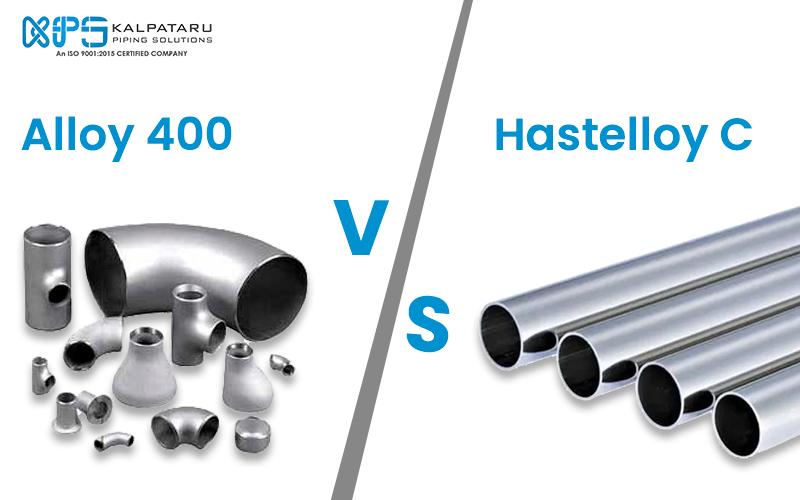Industries such as aerospace, chemical processing, and petrochemicals depend greatly on corrosion-resistant alloys to guarantee the longevity and strength of their equipment. Two prominent alloys in the market, namely Alloy 400 and Hastelloy C, have earned a reputation for their exceptional resistance to corrosion and proven performance in challenging conditions. Although both are favoured, they possess distinct properties that might impact the decision-making process. In this blog post, we will explore the disparities between Alloy 400 and Hastelloy C, offering valuable insights to assist you in making an informed selection.
What is the Difference Between Alloy 400 and Hastelloy C?
Corrosion-resistant alloys play a crucial role in sustaining the reliability and durability of equipment in various industries, including aerospace, chemical processing, and petrochemicals. Among the top contenders in this domain are Alloy 400 and Hastelloy C, two alloys that have garnered widespread recognition for their exceptional performance in harsh environments. In this blog post, we will delve into the dissimilarities between these two alloys across various aspects to help you make an informed choice for your specific application.
Composition:
Alloy 400, also known as Monel 400, is a nickel-copper alloy with a composition primarily comprising nickel (63-70%) and copper (20-29%). Additionally, it contains small amounts of iron, manganese, carbon, and silicon. On the other hand, Hastelloy C is a family of alloys that primarily consist of nickel, molybdenum, and chromium, with varying proportions based on the specific grade (e.g., Hastelloy C276). The distinct compositions of these alloys lay the foundation for their contrasting properties.
Corrosion Resistance:
Both Alloy 400 and Hastelloy C excel in corrosion resistance, making them highly suitable for applications in aggressive and corrosive environments. Alloy 400 exhibits exceptional resistance to various corrosive agents, including seawater, acids, and alkalis. This attribute makes it a preferred choice for marine applications and equipment exposed to brine solutions. On the other hand, Hastelloy C, with its high molybdenum and chromium content, offers superior resistance to a broader range of corrosive media, including sulfuric acid, hydrochloric acid, and chloride solutions. Therefore, Hastelloy C is often favoured in chemical processing and petrochemical industries where exposure to harsh chemicals is common.
Strength:
In terms of strength, Hastelloy C generally outperforms Alloy 400. The molybdenum and chromium content in Hastelloy C contributes to its higher strength and excellent mechanical properties, providing enhanced performance at elevated temperatures. In contrast, Alloy 400 possesses lower strength compared to Hastelloy C but maintains good ductility, making it suitable for certain applications that require formability and ease of fabrication.
Cost:
Due to its nickel and copper composition, Alloy 400 is relatively more cost-effective compared to the various grades of Hastelloy C, which contain higher amounts of nickel, molybdenum, and chromium. The cost difference between these alloys can be a critical factor when choosing the appropriate material for a specific project, especially when considering the scale and budget constraints.
Application:
The choice between Alloy 400 and Hastelloy C often hinges on the specific application requirements. Alloy 400 finds widespread use in marine engineering, chemical equipment, and the aerospace industry due to its excellent resistance to seawater and various acids. On the other hand, Hastelloy C is preferred for applications involving strong acids, harsh chemical environments, and high-temperature conditions. It is extensively utilized in chemical processing, pollution control, and oil and gas industries.
Other Differences:
Apart from the key differences mentioned above, Alloy 400 exhibits magnetic properties, whereas Hastelloy C is non-magnetic. This magnetic characteristic of Alloy 400 can be significant in certain applications where magnetic interference needs to be considered.
Conclusion:
In conclusion, both Alloy 400 and Hastelloy C are formidable contenders in the realm of corrosion-resistant alloys. The choice between these alloys should be guided by the specific requirements of your application. If cost-effectiveness, good corrosion resistance, and ease of fabrication are paramount, Alloy 400 could be the ideal choice. However, if your application demands exceptional corrosion resistance in aggressive chemical environments and high-temperature settings, Hastelloy C might be the more suitable option. Always consider the specific composition, mechanical properties, and cost implications to make an informed decision that aligns with your project’s needs.
Learn More About: Heat Treatment of Copper and Copper Alloys

